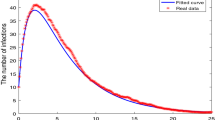Abstract
The purpose of the proposed paper is to analyze the dynamics of an epidemic model with fractional and fractal–fractional order by considering two different numerical approaches. Initially, we consider an epidemic model in fractional Atangana–Baleanu derivative and then obtain the necessary results associated with the model. Stability results for the model are obtained and showed that the model is stable when the basic reproduction number is less than unity. Then, we apply the new idea of fractal–fractional to the influenza model in the sense of Atangana–Baleanu fractional operator. The model with fractional and fractal–fractional operators is solved with numerical techniques. We present graphical results for fractional model with many values of \(\theta \). For the fractal–fractional model, we present a different set of fractal and fractional order to obtain graphical results. Further, we provide a comparison among the operators with novel numerical procedure considering different orders of \(\theta \). We conclude that the idea of fractal–fractional provides powerful results than that of fractional and integer-order derivative.














Similar content being viewed by others
References
Centers for Disease Control and Prevention (CDC), Types of Influenza Virus (Centers for Disease Control and Prevention (CDC), Atlanta, 2019). https://www.cdc.gov/flu/about/viruses/types.htm
Centers for Disease Control and Prevention (CDC), Information on Avian Influenza (Centers for Disease Control and Prevention (CDC), Atlanta, 2019). https://www.cdc.gov/flu/avianflu/index.htm
Centers for Disease Control and Prevention (CDC), Influenza Type a Viruses (Centers for Disease Control and Prevention (CDC), Atlanta, 2019). https://www.cdc.gov/flu/index.htm
S. Iwami, Y. Takeuchi, X. Liu, Avian-human influenza epidemic model. Math. Biosci. 207(1), 1–25 (2007)
J. Lucchetti, M. Roy, M. Martcheva, An Avian Influenza Model and Its Fit to Human Avian Influenza Cases. Advances in Disease Epidemiology (Nova Science Publishers, New York, 2009), pp. 1–30. ISBN 978-1-60741-452-0
E. Jung, S. Iwami, Y. Takeuchi, T.-C. Jo, Optimal control strategy for prevention of avian influenza pandemic. J. Theor. Biol. 260(2), 220–229 (2009)
S. Iwami, Y. Takeuchi, X. Liu, S. Nakaoka, A geographical spread of vaccine-resistance in avian influenza epidemics. J. Theor. Biol. 259(2), 219–228 (2009)
S. Iwami, Y. Takeuchi, X. Liu, Avian flu pandemic: can we prevent it? J. Theor. Biol. 257(1), 181–190 (2009)
S. Ruan, W. Wang, Dynamical behavior of an epidemic model with a nonlinear incidence rate. J. Differ. Equ. 188(1), 135–163 (2003)
A. Atangana, D. Baleanu, New fractional derivatives with nonlocal and non-singular kernel: theory and application to heat transfer model. arXiv preprint arXiv:1602.03408 (2016)
S. Ullah, M.A. Khan, M. Farooq, Modeling and analysis of the fractional HBV model with Atangana–Baleanu derivative. Eur. Phys. J. Plus 133(8), 313 (2018)
M.A. Khan, S. Ullah, M. Farooq, A new fractional model for tuberculosis with relapse via Atangana–Baleanu derivative. Chaos Solitons Fractals 116, 227–238 (2018)
E.O. Alzahrani, M.A. Khan, Modeling the dynamics of hepatitis e with optimal control. Chaos Solitons Fractals 116, 287–301 (2018)
M. Yavuz, N. Özdemir, European vanilla option pricing model of fractional order without singular kernel. Fractal Fract. 2(1), 3 (2018)
B.S.T. Alkahtani, Chua’s circuit model with Atangana–Baleanu derivative with fractional order. Chaos Solitons Fractals 89, 547–551 (2016)
A. Atangana, K.M. Owolabi, New numerical approach for fractional differential equations. Math. Model. Nat. Phenom. 13(1), 3 (2018)
O.J.J. Algahtani, Comparing the Atangana–Baleanu and Caputo–Fabrizio derivative with fractional order: Allen Cahn model. Chaos Solitons Fractals 89, 552–559 (2016)
H. Yépez-Martínez, J.F. Gómez-Aguilar, A new modified definition of Caputo–Fabrizio fractional-order derivative and their applications to the multi step homotopy analysis method (MHAM). J. Comput. Appl. Math. 346, 247–260 (2019)
J.F. Gómez-Aguilar, B. Dumitru, Fractional transmission line with losses. Z. Naturforschung A 69(10–11), 539–546 (2014)
J.F. Gómez-Aguilar, A. Atangana, New insight in fractional differentiation: power, exponential decay and Mittag-Leffler laws and applications. Eur. Phys. J. Plus 132(1), 13 (2017)
A. Atangana, J.F. Gómez-Aguilar, Hyperchaotic behaviour obtained via a nonlocal operator with exponential decay and Mittag-Leffler laws. Chaos Solitons Fractals 102, 285–294 (2017)
B. Cuahutenango-Barro, M.A. Taneco-Hernández, J.F. Gómez-Aguilar, On the solutions of fractional-time wave equation with memory effect involving operators with regular kernel. Chaos Solitons Fractals 115, 283–299 (2018)
H. Yépez-Martínez, F. Gómez-Aguilar, I.O. Sosa, J.M. Reyes, J. Torres-Jiménez, The fengs first integral method applied to the nonlinear mKdV space-time fractional partial differential equation. Rev. mex. fís. 62(4), 310–316 (2016)
A. Atangana, J.F. Gómez-Aguilar, Fractional derivatives with no-index law property: application to chaos and statistics. Chaos Solitons Fractals 114, 516–535 (2018)
A. Coronel-Escamilla, J.F. Gómez-Aguilar, L. Torres, R.F. Escobar-Jiménez, M. Valtierra-Rodríguez, Synchronization of chaotic systems involving fractional operators of Liouville–Caputo type with variable-order. Phys. A Stat. Mech. Appl. 487, 1–21 (2017)
J.F. Gómez-Aguilar, A. Atangana, V.F. Morales-Delgado, Electrical circuits RC, LC, and RL described by Atangana–Baleanu fractional derivatives. Int. J. Circuit Theory Appl. 45(11), 1514–1533 (2017)
A. Atangana, S. Qureshi, Modeling attractors of chaotic dynamical systems with fractal–fractional operators. Chaos Solitons Fractals 123, 320–337 (2019)
P. Van den Driessche, J. Watmough, Reproduction numbers and sub-threshold endemic equilibria for compartmental models of disease transmission. Math. Biosci. 180(1–2), 29–48 (2002)
M. Toufik, A. Atangana, New numerical approximation of fractional derivative with non-local and non-singular kernel: application to chaotic models. Eur. Phys. J. Plus 132(10), 444 (2017)
M.A. Khan, O. Kolebaje, A. Yildirim, S. Ullah, P. Kumam, P. Thounthong, Fractional investigations of zoonotic visceral leishmaniasis disease with singular and non-singular kernel. Eur. Phys. J. Plus 134(10), 481 (2019)
A. Atangana, Z. Hammouch, Fractional calculus with power law: the cradle of our ancestors? Eur. Phys. J. Plus 134(9), 429 (2019)
K.M. Owolabi, A. Atangana, Computational study of multi-species fractional reaction–diffusion system with ABC operator. Chaos Solitons Fractals 128, 280–289 (2019)
Acknowledgements
This project was funded by the Deanship of Scientific Research (DSR), King Abdulaziz University, Jeddah, under Grant No. D-112-130-1440. The authors, therefore, gratefully acknowledge the DSR for technical and financial support.
Author information
Authors and Affiliations
Corresponding author
Ethics declarations
Conflict of interest
The authors declare that no competing interests exist regarding the publication of this work.
Rights and permissions
About this article
Cite this article
Alzahrani, E.O., Khan, M.A. Comparison of numerical techniques for the solution of a fractional epidemic model. Eur. Phys. J. Plus 135, 110 (2020). https://doi.org/10.1140/epjp/s13360-020-00183-4
Received:
Accepted:
Published:
DOI: https://doi.org/10.1140/epjp/s13360-020-00183-4




